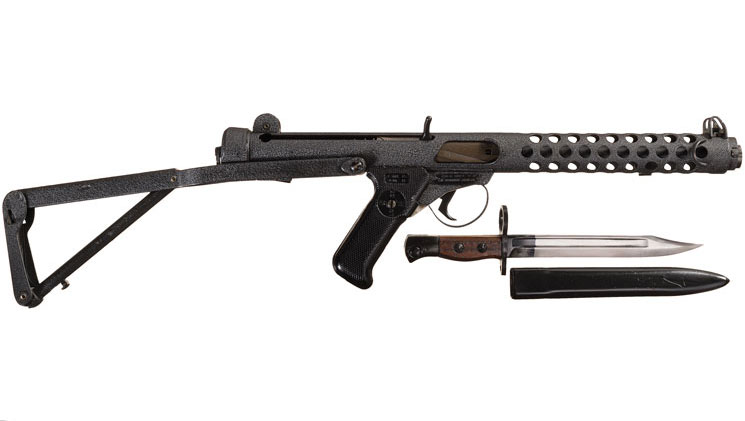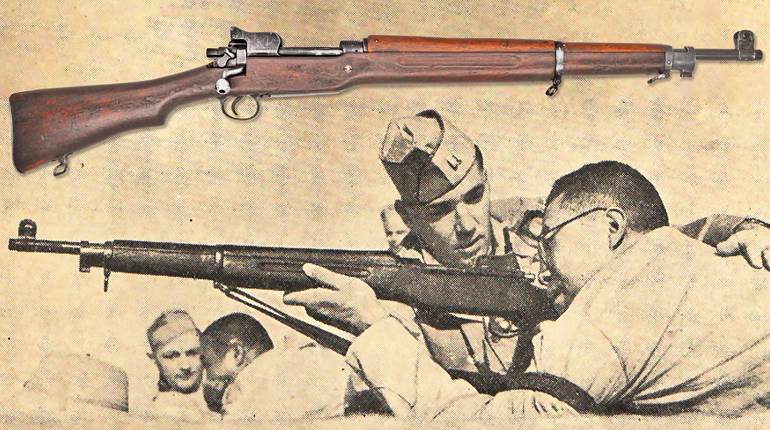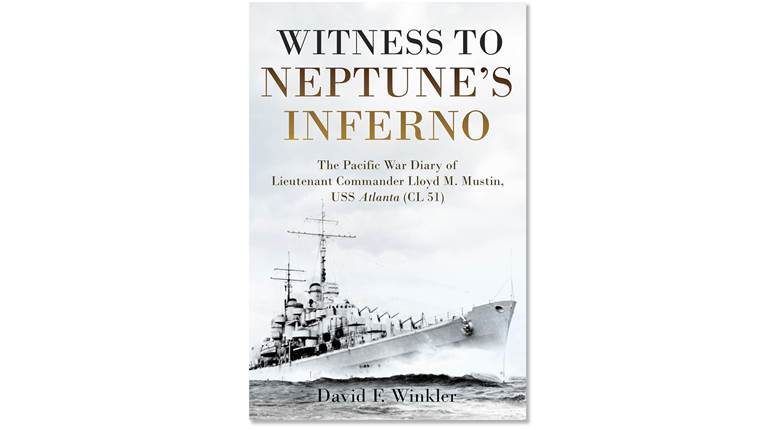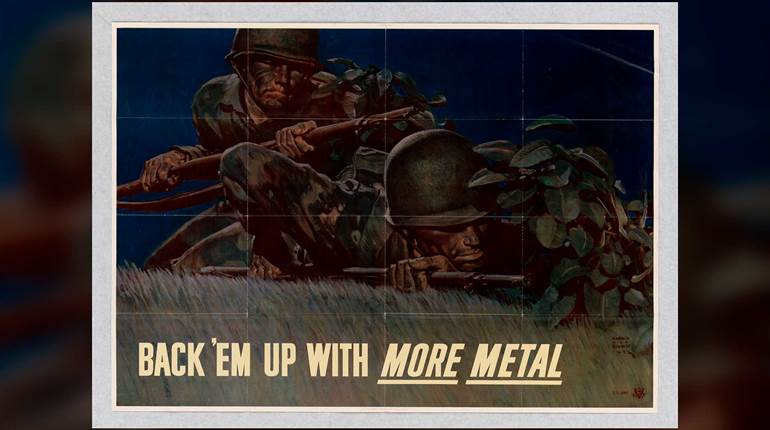
The Sterling submachine gun is one of Britain’s most iconic Cold War weapons. It saw action in more than 40 conflicts, was adopted by more than a dozen countries and remained in front-line service for nearly 60 years. The Sterling was developed at the tail end of World War II to replace the workhorse Sten gun, and remained in British service until 1994. Despite being a weapon of war, perhaps its most iconic use is its appearance in the “Star Wars” movies under the stage name of the E-11 blaster, the Imperial Stormtrooper’s weapon of choice.
The simple, cheap, but hastily made Sten had served the British military well throughout World War II, but by 1944 it was becoming clear that a new, more reliable weapon was needed. Compared to the workhorse Sten, the Sterling was a work of art – part of a new wave of post-war submachine guns; utilitarian but refined, robust but cost-effective. While its contemporaries like the Swedish Carl Gustav m/45 and Israeli Uzi may be better known, the Sterling has an impressive combat history. From Malaya to Kenya, from Yemen to Northern Ireland and from the Falklands to Iraq, the Sterling was present for many of Britain’s post-World War II conflicts. It was used not only by Britain, well over a million were produced seeing service with India, Canada, New Zealand, Argentina, Iraq and Malaysia.
The submachine gun that would become the Sterling was designed by George Patchett, a former motorcycle racer and designer. Patchett joined the Sterling Armaments Company in 1941 to assist in the production of the Lanchester Machine Carbine—a copy of the Bergmann MP28, which had been ordered into production alongside the much cheaper Sten gun. By 1942, however, Patchett had begun developing his own 9x19 mm blowback submachine gun.

George Patchett’s first patent for his "machine carbine" dating from August 1943. (US Patent Office)
Patchett filed his first patent protecting his new design in August 1942. This was quickly followed by the first testing of a tool-room prototype, built off of a left over Lanchester receiver tube. Patchett made his first demonstration on Sept. 25, 1942, when he fired a total of 412 rounds in front of officers from the British Army’s Ordnance Board. The prototype had no sights or stock, so Patchett fired from the hip. The Ordnance Board reported that “the carbine functioned satisfactorily,” but disliked the prototype’s lack of a stock and sights; they also noted concerns about the strength of the prototype’s end cap.

Patchett’s patent for his folding stock. (US Patent Office)
In early 1943, Patchett developed a folding stock for his machine carbine and brazed rudimentary sights to the prototype’s muzzle cap and receiver. In May 1943, he patented his folding stock that with a few improvements would come to characterize the Sterling. In late 1943, he patented the helical grooved bolt designed to help the gun function when dirt or mud got into the action. Early pre-production prototype Patchetts used the Sten’s 32-round double-stack, single-feed magazine and leftover Lanchester barrels and perforated receiver tubes. In March 1943, the Patchett began what would eventually total nearly a decade of official British military testing and evaluation.
During the first round of testing the Patchett struggled with accuracy, failing to hit the 175-yard target. This is unsurprising considering the rudimentary nature of the prototype’s brazed-on sights. The prototype redeemed itself, performing well in sand testing, but failed a mud test. The Ordnance Board reported that the Patchett was “capable of much improvement.”

The Sterling-made Lanchester Machine Carbine, adopted alongside the Sten early in the war, some 70,000 were produced. (Rock Island Auctions)
The following January, after making various improvements to the design, the government ordered 20 Patchett’s for trials at a cost of £4,464. These weapons were quickly assembled and delivered to the Ordnance Board on April 28, 1944, just as the Allies prepared for the invasion of France.
One of the most enduring mysteries surrounding the Patchett/Sterling is when exactly it first saw action. It has been suggested in the past that a number of Patchett machine carbines were issued to British paratroopers of 1st Airborne Division during Operation Market Garden in September 1944. Despite much research, however, I have been unable to find any documentary evidence to support this.
Four Patchetts were sent to the Airborne Forces Development Centre in April 1944 to evaluate how well-suited they were for use by airborne troops. Some may have found their way into action in Arnhem that way. The Imperial War Museum’s collection includes a Patchett Mk I machine carbine which was said to have been carried by Lt.-Col. Robert Dawson, commanding officer No. 4 Commando, during Operation Infatuate, the Allied landings to capture the occupied Dutch island of Walcheren in November 1944. Sadly, I have been unable to find any record of trials guns being issued to No. 4 Commando.

An earlier Mk1 Patchett prototype with straight Sten magazine. (Matthew Moss)
Perhaps the most compelling evidence comes from the introduction to an Ordnance Board report dating from January 1951. It mentions how the Patchett “had been used in action by Combined Operations troops [better known as the Commandos]” and had been recommended as a replacement for the Sten in January 1945. The most tantalizing evidence, however, is a grainy photograph of a group of men who are believed to be members of the Free French operating in the Netherlands during Operation Amherst in April 1945. The profile of the Patchett’s sweeping grip and folding stock is clear to make out. Sadly, this photograph also lacks the provenance to confirm the suggestion that the Patchett saw action with commandos during the war. For now, the mystery surrounding whether the Patchett saw action during World War II persists.
Testing of the Patchett continued after the war but Sterling was not the only company developing a submachine gun to meet the War Office’s requirements. Birmingham Small Arms (BSA) began developing a new experimental submachine gun in 1944, designed by Claude Perry. Over the next few years, the BSA Machine Carbine would become the Patchett’s staunchest rival. As the BSA gun impressed in trials, the Patchett suffered a series of reliability issues and by 1948 the BSA was pulling ahead.

The BSA Machine Carbine, the Patchett/Sterling’s main rival, an ambitious advanced design held back by a lack of funds and changing requirements. (Matthew Moss)
Some of the Patchett’s issues stemmed from a weak recoil spring, and by 1950 Patchett addressed this by introducing dual recoil springs, with a smaller spring nestled into a larger one. This increased the energy imparted on the bolt, and coupled with the design of a new curved magazine with an ingenious roller follower, solved the reliability issues.
Patchett’s submachine gun suffered another setback, however, when the British Army began to develop a new intermediate caliber assault rifle, the E.M.2. The new rifle was intended to fulfil not only the rifle role but also the machine carbine role, formerly filled by the Sten. With this new rifle, it seemed that a new submachine gun would only be needed for rear echelon troops. But political wrangling saw the U.S. push hard for the NATO standardization of its new 7.62×51 mm ammunition, and the British were obliged to pragmatically abandon the E.M.2. Instead the FN FAL was adopted as the L1A1, and the need for a smaller, lighter personal weapon for radio operators, mortar teams, vehicle crews and medics re-emerged.
In 1951, testing of the BSA and Patchett resumed with the improved Patchett MKII outperforming its rival in both reliability and adverse-conditions testing. The Patchett was approved for troop trials and one evaluating officer succinctly summed up the general opinion of the Patchett: “it has all the advantages and none of the disadvantages of the Sten.”
Finally, after a decade of development, refinement, testing and evaluation, the British Army adopted the Patchett in September 1953, as the L2A1. Over the next two years, further improvements to the stock and sights were made and finally the weapon was standardized as the L2A3—commonly referred to as the Sterling—after the company that produced it rather than the man who designed it.
The new submachine gun was almost immediately in action. It had seen limited combat field testing in Korea with the British and Australians but it was soon thrust into counter-insurgency operations in Malaya and Kenya. During the Anglo-French operation to regain control of the Suez Canal from Egypt in 1956, Sterling submachine guns were used by both sides and met in combat for the first time. During the Indonesian Confrontation (1963-66), the Sterling faced some of the harshest conditions imaginable. In August 1964, a jungle patrol from a battalion of Gurkha Rifles was ambushed by communist insurgents. With the patrol’s Bren gun knocked out, Lance Corporal Amarjit Pun, armed with a Sterling, rushed forward and laid down suppressing fire until the rest of the patrol could reform and counter attack. He was awarded the Military Medal for his bravery.
The Sterling subsequently saw action in Aden, Northern Ireland and during the Falklands War. On the night of April 2, 1982, Sterlings clashed again as Argentine commandos, armed with both standard and suppressed Sterling submachine guns, attacked the Royal Marines of Naval Party 8901, some armed with L2A3s, defending Government House.

A combined-services patrol in Aden, 1965. The Military-police patrols were typically armed with pistols and Sterling L2A3 submachine guns. (Imperial War Museum)
During the British task force to retake the islands, several gallantry medals were won by men armed with Sterlings. Lieutenant-Colonel Herbert ‘H’ Jones, commanding officer of 2 PARA, was killed at the Battle of Goose Green leading his men against Argentine positions. But it was not just on land that the Sterling saw action during operations in the Falklands. On May 21, British frigate HMS Ardent came under attack from Argentine A-4 Skyhawks. Armed with 1,000 lb. bombs, the Skyhawks attacked Ardent and another frigate, HMS Yarmouth. Ardent’s anti-aircraft missile system failed to lock on to the attacking aircraft and they were able to score several hits on the frigate. In a desperate effort to defend his ship, Lt. Cdr. John Murray Sephton organized the use of small arms, directing fire against the Skyhawks. A final wave of Argentine Navy Skyhawks attacked, and Lt. Cdr. Sephton and his men engaged with small arms in an attempt to defend the ship. Reportedly, Sephton stood on Ardent’s flight deck firing a Sterling at a Skyhawk as it flew overhead. The bomb that this aircraft dropped struck the flight deck, killing Sephton and three other members of the crew. For his actions Sephton was posthumously awarded the Distinguished Service Cross. The Ardent was heavily damaged, so her surviving crew were evacuated before she sank the next day.

Indian Sailor armed with an Indian-made Sterling, a 1A1 Carbine, during an exercise in 2009. (US Navy/Cynthia Griggs)
The Gulf War was the last conflict in which the British Sterlings saw action, but the venerable submachine gun has seen continued service in huge numbers with the Indian army and police forces. The Canadian army also adopted a variant of the Sterling, the C1, in 1959. Like its British counterpart, it was only retired in the early 1990s when it was replaced by the C7 rifle.
Perhaps the Sterling’s most lasting legacy is its starring roles on screen. Making its debut in the classic Michael Caine spy movie, “The IPCRESS File” (1965), the Sterling also appeared in the hands of another famous spy, featuring in numerous James Bond films starting with “You Only Live Twice” (1967). It also featured in cult classics including “The Wild Geese” (1978) and “RoboCop” (1987). But its most iconic role came when armourers from Bapty & Co. converted a number of Sterling Mk 4s to become the BlasTech E-11 blaster rifles used by Imperial stormtroopers in the first three “Star Wars” movies.

An Imperial Stormtrooper’s Sterling in its E-11 Blaster guise. (Profiles in History)
Both firing and non-firing prop blasters were made for the films, with around 20 Sterling Mk 4s retrofitted for A New Hope. The blasters were assembled from available parts; the majority had an American M38 azimuth tank scope fixed to the top of the receiver with a special custom-made mount. A Hengstler industrial counter box was attached to the left side of the receiver, and two small cylinders were added on top of the magazine housing. A series of ribs were fixed to the perforated barrel jacket, and the distinct look of the blaster was completed using much shorter, cut-down 10-round magazines.
The Mk 4 was also the basis of the Rebel Alliance’s DH-17 blaster pistol, which featured in the original trilogy of “Star Wars” films as well as more recently in “The Force Awakens” (2015) and “Rogue One” (2016). It is worth noting that throughout the films, the Imperial stormtroopers never deploy their blasters’ stocks, perhaps accounting for their legendary inaccuracy. The Sterling has percolated into popular consciousness, arming charismatic spies and stormtroopers alike; its screen legacy will undoubtedly continue for years to come.
Despite production in the U.K. ending in 1988, when the Sterling Armaments Company closed down, production in other countries has seen a total of well over 1 million Sterlings produced. The Sterling’s legacy is not only as a weapon of war, but also as a cultural symbol, unexpectedly immortalised in popular culture.
Matthew Moss has written a new book on the history, development and use of the Sterling Submachine Gun, published by Osprey on Nov. 29, 2018. More information here.






































